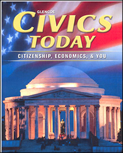Civics Today Citizenship, Economics, & YouChapter 21:
Demand and SupplyWeb Activity Lesson PlansIntroduction
In this chapter students read about the economic concept of demand. Demand refers to the desire, willingness, and ability to buy a good or service. For some goods demand is high at particular times of the year. Businesses try to anticipate demand and produce the goods that consumers want. Sometimes they are unsuccessful. In this activity students will examine one example of what happens when demand spirals out of control.
Lesson Description
In this lesson students will visit the Financial Pipeline Web site. Here they will read an article about the Tickle Me Elmo craze of Christmas 1996. This article analyzes the effects of demand in that situation. After reading the article they will answer questions and then create an advertisement for a product in the hope that it will create a similar market demand.
Instructional Objectives- The learner will be able to describe forces that create demand.
- The learner will be able to create an advertisement that would raise demand for a product of their choice.
Student Web Activity Answers- The appearance of the toy on a talk show where it was introduced as a cute Christmas gift played a role in increasing demand.
- Suppliers didn't know that the toy would be a large seller and didn't want to be stuck with a large inventory after the Christmas selling season.
- When there was a shortage of the toys, prices rose dramatically.
- Parents experienced fear that their children would not have the present they wanted and greed to be the one that would have the toy. Competition among shoppers increased. Some people became toy "scalpers."
- Students' ads will vary.
 | 




